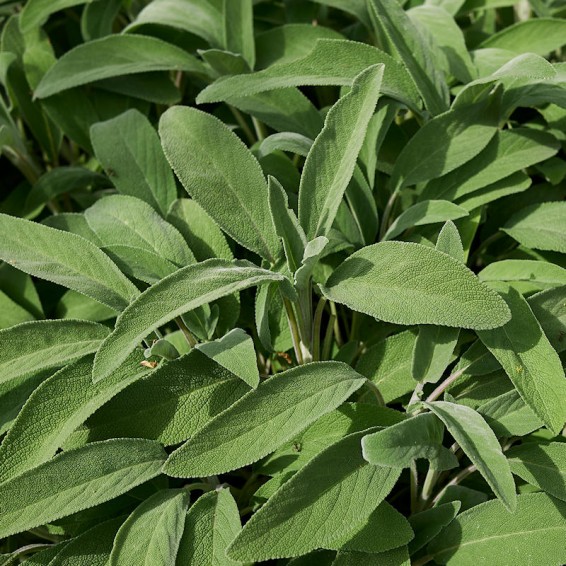Organic Broadleaf Sage Seeds
- HOW TO GROW
- FAST FACTS
- REVIEWS
HOW TO GROW
Sowing: Start sage indoors 6-8 weeks before the last frost of spring. Sow the seeds just below the surface of the soil, and keep the soil at a temperature of 65-70 degrees F. Keep the soil lightly moist with a spray bottle or careful watering; germination should take place within 2-3 weeks, and the germination rate will be naturally low. Transplant after the last spring frost in light, well drained soil and full sun or partial shade. Space the plants 12-15" apart. Direct sowing is not recommended, since the seeds take much longer to germinate in the cooler soil of spring; this significantly delays their growth. As a companion plant, sage repels the harmful cabbage butterfly and also protects carrots from insect pests. Avoid planting sage near cucumbers. Sage also grows well indoors or as a container plant.
Growing: Though young seedlings need water regularly, mature sage develops the strongest flavor when left alone with minimal watering and no fertilization. Do not overwater, since this may cause root rot. Established plants should be pruned both in the spring and after blooming to encourage new growth and create a bushy, compact plant. After about four years, sage begins to lose its potency and may need to be replanted from cuttings. A layer of mulch will be helpful to protect the plants over winter.
Harvesting: When started from seed, sage should not be harvested until the second year of its growth to allow the plant to become established. Harvest fresh leaves as needed; the best time for harvesting is in the morning, after the dew has dried. Fresh leaves achieve their peak flavor right before the plant flowers, but after this point the flavor declines. The leaves have the best flavor when fresh, but they can also be frozen and keep very well when dried. Since sage tends to lose its flavor when heated, add it to hot food immediately before serving.
Seed Saving: Harvest the seed heads individually as soon as they begin to dry and develop mature seed. Spread them out to dry completely, and thresh them to remove the seed. Store the seed in a cool, dry place.
FAST FACTS
Common Names: Garden Sage, Common Sage, Culinary Sage, Golden Sage, Kitchen Sage, Dalmatian Sage
Latin Name: Salvia officinalis
Species Origin: Mediterranean, Northern Africa
Type: Open Pollinated, Heirloom, Warm Season
Life Cycle: Perennial
USDA Zones: 4, 5, 6, 7, 8, 9
Seeds per Ounce: 3,750
Planting Method: From Transplant
Sunlight: Full Sun, Part Sun
Height: 24 Inches
Color: Green, Blue
Bloom Season: Blooms Early Summer, Blooms Late Summer
Uses: Attracts Honeybees, Attracts Butterflies, Aromatic, Deer Resistant
Refunded
Glad you were available to provide amazing service and products during this challenging time!
Thank you for promptly refunding me for this unavailable product!
DESCRIPTION
HOW TO GROW
Sowing: Start sage indoors 6-8 weeks before the last frost of spring. Sow the seeds just below the surface of the soil, and keep the soil at a temperature of 65-70 degrees F. Keep the soil lightly moist with a spray bottle or careful watering; germination should take place within 2-3 weeks, and the germination rate will be naturally low. Transplant after the last spring frost in light, well drained soil and full sun or partial shade. Space the plants 12-15" apart. Direct sowing is not recommended, since the seeds take much longer to germinate in the cooler soil of spring; this significantly delays their growth. As a companion plant, sage repels the harmful cabbage butterfly and also protects carrots from insect pests. Avoid planting sage near cucumbers. Sage also grows well indoors or as a container plant.
Growing: Though young seedlings need water regularly, mature sage develops the strongest flavor when left alone with minimal watering and no fertilization. Do not overwater, since this may cause root rot. Established plants should be pruned both in the spring and after blooming to encourage new growth and create a bushy, compact plant. After about four years, sage begins to lose its potency and may need to be replanted from cuttings. A layer of mulch will be helpful to protect the plants over winter.
Harvesting: When started from seed, sage should not be harvested until the second year of its growth to allow the plant to become established. Harvest fresh leaves as needed; the best time for harvesting is in the morning, after the dew has dried. Fresh leaves achieve their peak flavor right before the plant flowers, but after this point the flavor declines. The leaves have the best flavor when fresh, but they can also be frozen and keep very well when dried. Since sage tends to lose its flavor when heated, add it to hot food immediately before serving.
Seed Saving: Harvest the seed heads individually as soon as they begin to dry and develop mature seed. Spread them out to dry completely, and thresh them to remove the seed. Store the seed in a cool, dry place.
FAST FACTS
Common Names: Garden Sage, Common Sage, Culinary Sage, Golden Sage, Kitchen Sage, Dalmatian Sage
Latin Name: Salvia officinalis
Species Origin: Mediterranean, Northern Africa
Type: Open Pollinated, Heirloom, Warm Season
Life Cycle: Perennial
USDA Zones: 4, 5, 6, 7, 8, 9
Seeds per Ounce: 3,750
Planting Method: From Transplant
Sunlight: Full Sun, Part Sun
Height: 24 Inches
Color: Green, Blue
Bloom Season: Blooms Early Summer, Blooms Late Summer
Uses: Attracts Honeybees, Attracts Butterflies, Aromatic, Deer Resistant
Reviews
Review
Refunded
Glad you were available to provide amazing service and products during this challenging time!
Thank you for promptly refunding me for this unavailable product!






